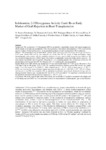Mostrar o rexistro simple do ítem
Indoleamine, 2-3 dioxygenase activity could be an early marker of graft rejection in heart transplantation
| dc.contributor.author | Suárez-Fuentetaja, Natalia | |
| dc.contributor.author | Doménech, Nieves | |
| dc.contributor.author | Paniagua-Martín, María J. | |
| dc.contributor.author | Marzoa Rivas, Raquel | |
| dc.contributor.author | Barge-Caballero, Eduardo | |
| dc.contributor.author | Grille Cancela, Zulaika | |
| dc.contributor.author | Pombo-Otero, Jorge | |
| dc.contributor.author | Muñiz, Javier | |
| dc.contributor.author | Castro-Beiras, Alfonso | |
| dc.contributor.author | Crespo-Leiro, María Generosa | |
| dc.date.accessioned | 2015-08-28T10:40:23Z | |
| dc.date.available | 2015-08-28T10:40:23Z | |
| dc.date.issued | 2012-11-10 | |
| dc.identifier.citation | Suárez-Fuentetaja N, Domenech-García N, Paniagua-Martín MJ, Marzoa-Rivas R, Barge-Caballero E, Grille-Cancela Z, et al. Indoleamine, 2-3 dioxygenase activity could be an early marker of graft rejection in heart transplantation. Transplant Proc. 2012;44(9):2645-2648 | es_ES |
| dc.identifier.uri | http://hdl.handle.net/2183/14891 | |
| dc.description.abstract | [Abstract] Background. The indoleamine, 2-3 dioxygenase (IDO) is an inducible intracellular enzyme with immunosuppressive effects mainly on lymphocyte populations. It has been postulated that indirect determination of IDO serum activity may be a marker of renal graft rejection, but its potential usefulness in heart transplantation (HT) is unknown. Methods. This longitudinal study included 98 HT patients (83% males) who survived ≥1 year. Mean age was 54.14 ± 11.57 years. Serum IDO activity was analyzed one month after HT by means of high performance liquid chromatography and correlated with the cumulative incidence of acute rejection (AR) during one-year follow-up. AR was defined as biopsy-proven ≥ ISHLT grade 2R rejection or empirically treated non-biopsy-proven rejection. The study sample was divided into two groups: AR group (n = 51), including patients who experienced at least one AR episode during the first year after HT; No-AR group (N = 47), including the remaining patients. Results. Mean serum IDO activity one month after HT was significantly higher (P = .021) in the AR group (3.32 ± 1.56) than in the no-AR group (2.62 ± 1.35). No significant association between serum IDO activity and gender (male: 3.1 ± 1.56, women: 2.43 ± 0.99, P = .092), recipient age (r = −.07, P = .943) or donor age (r = 0.108, P = 0.293) was observed. By means of binary logistic regression, an odds ratio of 1.4 [CI 95%: 1.033-1.876, P = .03] per unit increase of act-IDO was estimated, with no significant modification upon forced adjustment for age and sex. Mean glomerular filtration rate 1 month after HT was 67.01 ± 28.51 mL/min/m2. No significant correlation between this parameter and serum IDO activity was observed (r = .160, P = .117). Conclusions. Our study suggests that serum IDO activity one month after HT might be associated with a higher risk of AR during one-year follow-up. This association seems to be independent of recipient gender, age or renal function. | es_ES |
| dc.language.iso | eng | es_ES |
| dc.publisher | Elsevier | es_ES |
| dc.relation.uri | http://dx.doi.org/10.1016/j.transproceed.2012.09.036 | es_ES |
| dc.rights | Creative Commons Licence | es_ES |
| dc.rights | Reconocimiento-NoComercial-SinObraDerivada 4.0 Internacional | |
| dc.rights.uri | http://creativecommons.org/licenses/by-nc-nd/4.0/ | |
| dc.title | Indoleamine, 2-3 dioxygenase activity could be an early marker of graft rejection in heart transplantation | es_ES |
| dc.type | info:eu-repo/semantics/article | es_ES |
| dc.rights.access | info:eu-repo/semantics/openAccess | es_ES |
Ficheiros no ítem
Este ítem aparece na(s) seguinte(s) colección(s)
-
GI- GRINCAR - Artigos [203]






